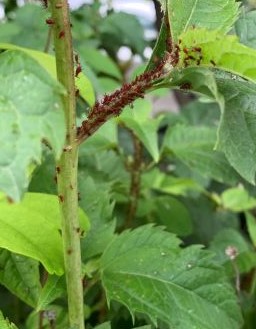
Greetings, gardening gurus! I have a large patch of False Sunflower ‘Bleeding Hearts’ Heliopsis helianthoides var. scabra, which for the first time this year are utterly infested with tiny red insects about 1/32″ long. They are literally end to end and shoulder to shoulder on the stems of every plant. There also seems to be a sticky residue on the leaves. So far (touch wood) they have not spread to any other perennial in my garden. When I squish them (ewww) they are red. Any idea what these are, and what I can do about them? Many thanks in advance!
Unfortunately, your lovely plants have a Red Aphid (Dactynotus spp.) infestation. These little insect pests feed on the sap of new plant growth. They in turn produce honeydew, which is the sticky stuff you mention seeing. This can lead to a sooty mold problem which can be more detrimental to your plants than the aphids. So all that being said, my advice would be to tackle this issue as soon as you can as aphids are born live, take only one week to reach maturity so your infestation will grow larger quickly.
Red aphids do have natural predators such as lady beetles, lacewings and parasitic wasps but there may not be an abundance locally to keep your population under control. Your local nursery or garden centre may have lady beetles in cold storage for you to purchase so it may be worth a phone call or two.
Good practices such as removing aphid infested weeds and not feeding with a high Nitrogen fertilizer in order to slow new susceptible growth, may be of some benefit.
Using a hose to give plants a good thorough spraying with water, knocking off the aphids is remarkably effective as is hand scraping. If neither of these options is controlling things, you may have to cut back the badly infested sections (only by 1/3), and dispose of them in the garden waste (do not add to your home compost). This will result in a slightly later flowering but will be worth it to rid your plants of this pest.
If all else fails, insecticidal soap can be purchased at most garden centres and nurseries. Repeated spraying may be needed as it has to come into contact with each insect. It is vital that the product instructions be followed carefully for optimal results.
Hope this helps.

